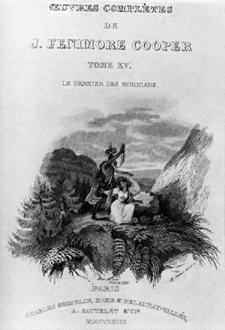Cooper's Indians
 Cooper has long been hailed by literary critics as creating one of the most enduring images of the Native American in American literature. In The Indian in American Literature, Albert Keiser states that "the writer who more than anyone else impressed his conception of the Indian upon America and the world at large is James Fenimore Cooper (1789-1851), in eleven of whose books the red man plays a prominent part" (101). These eleven books are the five Leatherstocking Tales, The Chainbearer, The Oak Openings, The Redskins, Satanstoe, The Wept of Wish-ton-wish, and Wyandotte.
Cooper has long been hailed by literary critics as creating one of the most enduring images of the Native American in American literature. In The Indian in American Literature, Albert Keiser states that "the writer who more than anyone else impressed his conception of the Indian upon America and the world at large is James Fenimore Cooper (1789-1851), in eleven of whose books the red man plays a prominent part" (101). These eleven books are the five Leatherstocking Tales, The Chainbearer, The Oak Openings, The Redskins, Satanstoe, The Wept of Wish-ton-wish, and Wyandotte.
While Cooper's Indians undeniably made an important impact on American fiction, they have been the subject of much literary debate. The most common charge leveled against Cooper is that the Indians did not resemble any that could be found in life; simply, they were wildly unrealistic. Indeed, Cooper did not have much first-hand knowledge of American Indians. In Savagism and Civilization, Roy Pearce states, "Cooper was interested in the Indian not for his own sake but for the sake of his relationship to the civilized men who were destroying him. So far as we can tell, Cooper had little personal contact with Indians. Rather, he read widely in the best authorities on individual tribes; in particular, we know that he read of the Delawares in Heckewelder and of the Plains Indians in Biddle's account of the expedition of Lewis and Clark..." (200). In fact, Cooper told his friend Sir Charles Augustus Murray, "I never was among the Indians. All I know of them is from reading, and from hearing my father speak of them" (qtd. in Pearce 200)
However, Cooper's limited exposure to American Indians seems to have been enough for many readers to accept his characters. Furthermore, Cooper himself denied that they were unrealistic in the introduction to Last of the Mohicans; instead, he claimed poetic license. He asserted: "the reader who takes up these volumes in expectation of finding an imaginary and romantic picture of things which never had an existence will probably lay them aside, disappointed. The work is exactly what is professes to be in its title page--a narrative" (ix). Cooper asserts that while his texts do not reflect historical events, they preserve historical flavor.
In Cooper's travel narratives, Notions of the Americans, he does not indulge in any fanciful ideology concerning the American Indian present or future situation.
Pearce states: "In the Notions he might hope for gradual civilization of the Indians, but he was forced to admit that savage heroism, as he called it, was doomed, even in the west, to go down before civilized heroism" (201). His chapter addressing "Indians" is an excellent contrast to his Indian characters in Last of the Mohicans.
 Cooper has long been hailed by literary critics as creating one of the most enduring images of the Native American in American literature. In The Indian in American Literature, Albert Keiser states that "the writer who more than anyone else impressed his conception of the Indian upon America and the world at large is James Fenimore Cooper (1789-1851), in eleven of whose books the red man plays a prominent part" (101). These eleven books are the five Leatherstocking Tales, The Chainbearer, The Oak Openings, The Redskins, Satanstoe, The Wept of Wish-ton-wish, and Wyandotte.
Cooper has long been hailed by literary critics as creating one of the most enduring images of the Native American in American literature. In The Indian in American Literature, Albert Keiser states that "the writer who more than anyone else impressed his conception of the Indian upon America and the world at large is James Fenimore Cooper (1789-1851), in eleven of whose books the red man plays a prominent part" (101). These eleven books are the five Leatherstocking Tales, The Chainbearer, The Oak Openings, The Redskins, Satanstoe, The Wept of Wish-ton-wish, and Wyandotte.
